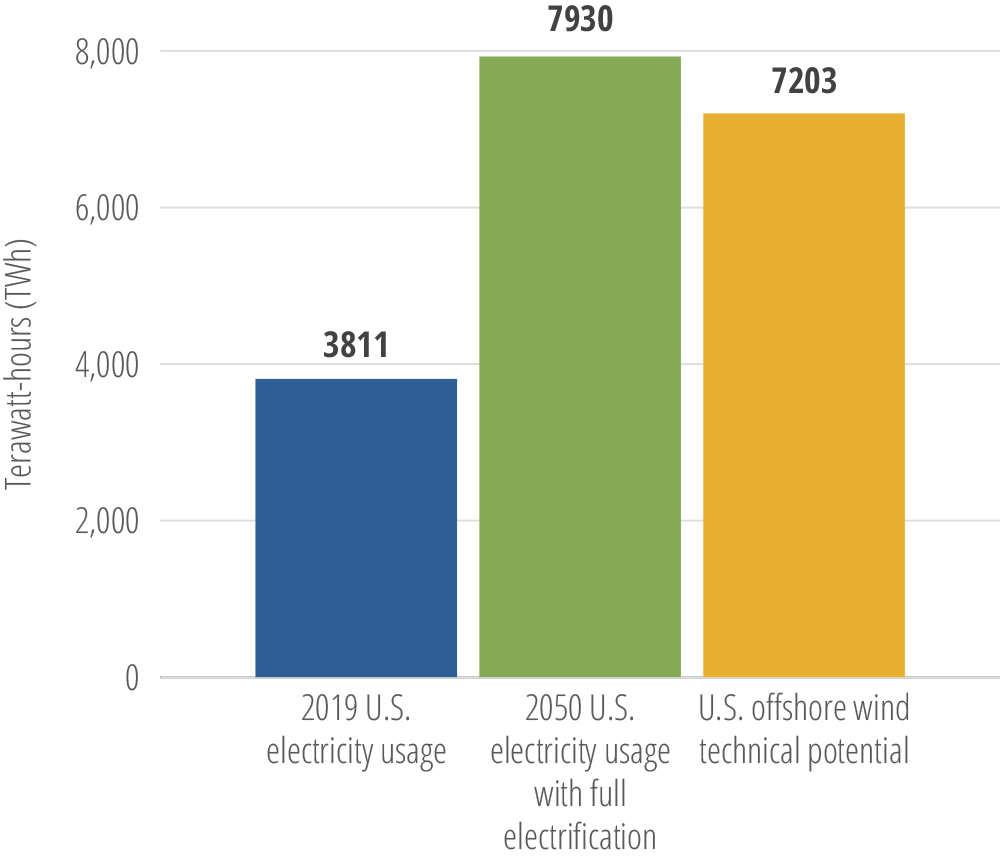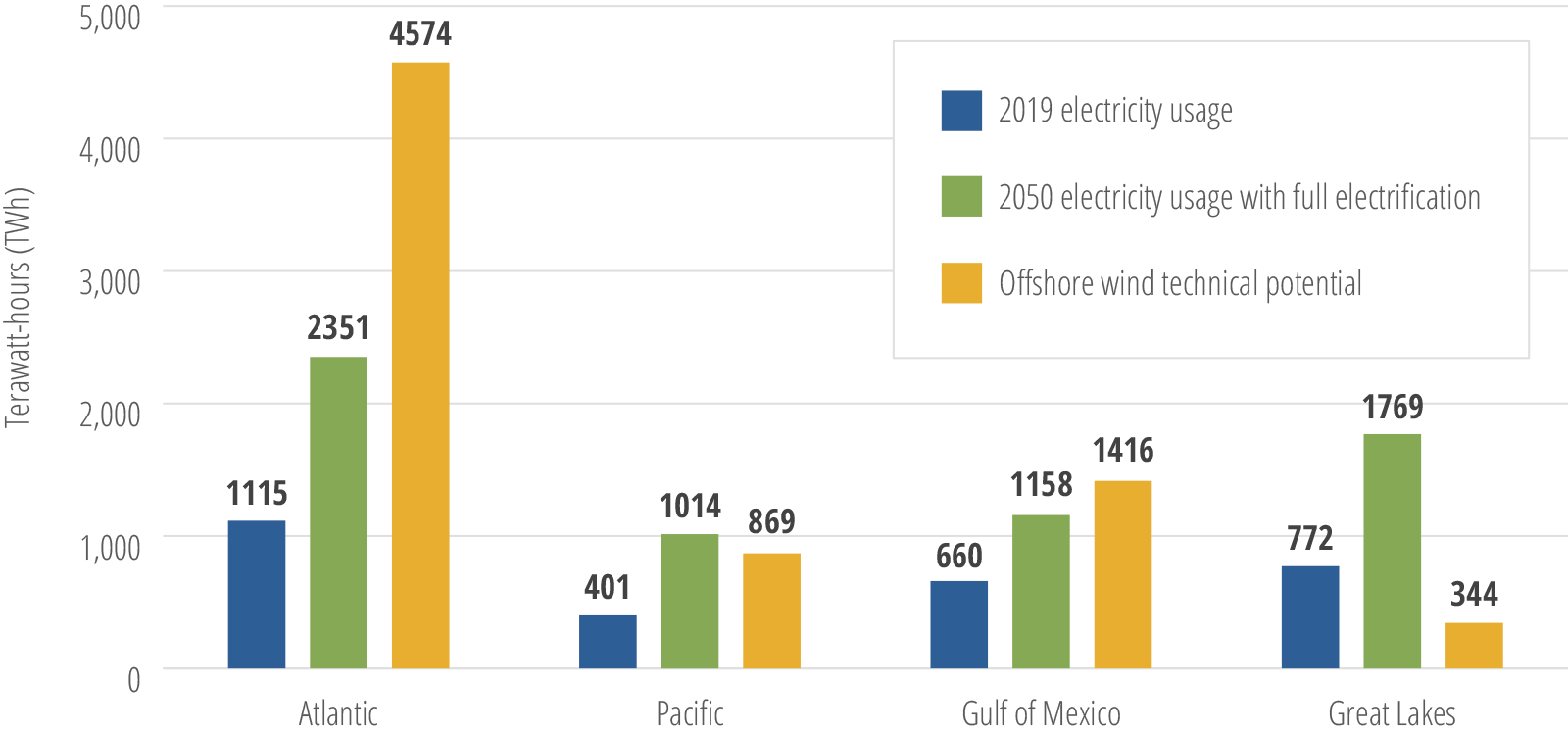The United States currently relies heavily on fossil fuels to heat our homes, fuel our cars, power our machines and produce electricity, harming our health and our climate.
Across the country, however, America is beginning to embrace the promise of clean, renewable energy. Today, the U.S. gets about 11.5% of our electricity from wind, solar and geothermal sources, up from about 0.6% two decades ago. America’s abundant renewable energy resources, coupled with energy efficiency measures and technological advances that make renewable energy cheaper and better than ever, open the possibility of transitioning our entire economy to run on 100% renewable energy.
To get there, we must take advantage of a massive and underutilized energy resource just off our coasts: offshore wind. That will require policymakers to remove the barriers slowing down the growth of the offshore wind industry, and instead support and hasten that growth to provide clean energy where it’s needed most.
Offshore wind has the technical capacity to power the country with clean energy. The United States has the technical potential to produce more than 7,200 terawatt-hours (TWh) of electricity from offshore wind, which is almost two times the amount of electricity the U.S. consumed in 2019 and about 90% of the amount of electricity the nation would consume in 2050 if we electrified our buildings, transportation system and industry and transitioned them to run on electricity instead of fossil fuels.
Figure ES-1: U.S. offshore wind technical potential and electricity usage (electrification scenario based on research by National Renewable Energy Laboratory)
Nineteen of the 29 states with offshore wind potential have the technical capacity to produce more electricity from offshore wind than they used in 2019. And 11 of them have the technical capacity to produce more electricity than they would use in 2050 if the country electrified homes and commercial buildings, transportation and industry. While the U.S. neither will, nor should, develop all of its technical potential for offshore wind energy, the sheer size of the resource illustrates the critical contribution that offshore wind can make toward an energy system powered by 100% renewable energy.
Every coastal region of the United States has offshore wind potential, though opportunities and obstacles to offshore wind development vary by region.
- The Atlantic region – from Maine to Florida – has the technical potential to produce almost 4,600 TWh of electricity each year, more than four times as much power as those states used in 2019, and almost twice as much as they would use in 2050 if the country underwent maximal electrification, based on estimates from the National Renewable Energy Laboratory. The Atlantic region, especially the Northeast, has strong, consistent wind and a wide, shallow continental shelf, making deployment of offshore wind relatively straightforward using existing technology.
- The Pacific region – including Hawaii but excluding Alaska – has the technical potential to produce almost 869 TWh of electricity each year from offshore wind, more than twice as much as it used in 2019, and almost 90% of what it is projected to use in 2050, assuming maximum electrification. The Pacific region has a very narrow continental shelf, resulting in much of the wind resource being in deep water and necessitating the use of floating turbines.
- The Gulf region – Texas, Louisiana, Mississippi and Alabama – has the technical potential to produce more than 1,400 TWh of electricity each year from offshore wind generation, more than twice the amount of electricity the region used in 2019 and over 20% more electricity than the region would use in 2050 assuming the country undergoes maximum possible electrification. The Gulf region’s low wind speeds and many conflicting uses reduce the area available for offshore wind development.
- The Great Lakes region – Illinois, Indiana, Michigan, Minnesota, Pennsylvania, Ohio and Wisconsin – has the technical potential to produce 344 TWh of electricity each year from offshore wind generation, almost half as much as it used in 2019 and about one fifth as much as it is projected to use in 2050 after maximal electrification. The Great Lakes region is limited in usable area and hampered by winter ice floes that could damage floating turbines.
Figure ES-2: Regional offshore wind technical potential and electricity usage
Out of every state in the U.S., Massachusetts has the largest potential offshore wind generation capacity, while Maine has the highest ratio of potential generation capacity to electricity usage.
Offshore wind technology is advanced and proven, widely deployed in Europe and Asia, and continues to improve.
- There are more than 5,500 offshore turbines currently deployed around the world, and more than 27 gigawatts (GW) of installed generating capacity – enough to power 7.3 million U.S. homes.
- The average capacity of the turbines currently installed is more than 12 times larger than that of the turbines in the first offshore wind farm built in 1991, and today’s turbines are hundreds of feet taller and more efficient even than turbines installed in 2010. They are being installed in much deeper water, and tens of miles farther from shore.
- Turbines that will be available in the next few years promise a new level of efficiency and generation capacity and could help reduce the costs of offshore wind while helping it power more of our energy needs.
The United States already has many projects in the development pipeline. In addition to the two operational pilot projects, there are 34 proposals for offshore wind development, which includes 27 projects in various stages of planning and development. Together, they total more than 26 GW of site capacity. The U.S. is set to see huge growth in offshore wind, which will help mature the industry and continue to drive down costs.
Offshore wind can help repower the U.S. with clean energy – but taking advantage of the opportunity will require support from policymakers and regulatory bodies. To help the industry grow, and to hasten the transition to renewable energy, governments and regulatory agencies at all levels should:
- Provide market certainty for offshore wind, as Connecticut, Maryland, Massachusetts, New Jersey, New York and Virginia have done by setting enforceable targets for offshore wind deployment.
- Support domestic supply chain development.
- Set national standards to ensure the environmental integrity of offshore wind projects and to avoid, minimize and mitigate impacts to marine ecosystems and wildlife.
- Direct the Bureau of Ocean Energy Management and relevant state agencies to accelerate the offshore wind leasing and permitting process while ensuring transparency and environmental responsibility.
- Increase and extend tax credits for offshore wind power.
- Plan for regional offshore wind development, including transmission infrastructure.
- Support research and development of new offshore wind technologies.
- U.S. Energy Information Administration, U.S. Energy Facts Explained, 7 May 2020, archived at http://web.archive.org/web/20210116015521/https://www.eia.gov/energyexplained/us-energy-facts/.
- Using 2020 11-Month Total and 2001 data: Energy Information Administration, Monthly Energy Review, February 2021, Table 7.2b Electricity Net Generation: Electric Power Sector,23 February 2021, archived at https://web.archive.org/web/20210223172509/https://www.eia.gov/totalenergy/data/monthly/pdf/sec7_6.pdf.
- See Methodology.
- Electrification refers to replacement of fossil fuel-powered appliances, vehicles and machinery with alternatives that run on electricity. See Methodology.
- Developable area on p. 46-47 and the problems with ice on p. 5: Walter Musial, et al., 2016 Offshore Wind Energy Resource Assessment for the United States, National Renewable Energy Laboratory, September 2016, archived at https://web.archive.org/web/20201206044939/https://www.nrel.gov/docs/fy16osti/66599.pdf.
- 5,500 turbines: International Energy Agency, Offshore Wind Outlook 2019: World Energy Outlook Special Report, November 2019, p. 15, downloaded from https://www.iea.org/reports/offshore-wind-outlook-2019; Global capacity: Walter Musial, et al., 2019 Offshore Wind Technology Data Update, National Renewable Energy Lab, October 2020, p. 27, archived at http://web.archive.org/web/20210110172118/https://www.nrel.gov/docs/fy21osti/77411.pdf; 7.3 million homes calculated by multiplying 27 GW of capacity by the number of hours in a year and by a 33% capacity factor to find 78,236.6 GWh of energy generated annually and then dividing by 0.01065 GWh average annual use by U.S. homes; Capacity factor from International Energy Agency, Offshore Wind Outlook 2019: World Energy Outlook Special Report, November 2019, p. 20, downloaded from https://www.iea.org/reports/offshore-wind-outlook-2019; Average annual electricity use in U.S. homes from U.S. Energy Information Administration, How Much Electricity Does an American Home Use?, 9 October 2020, archived at http://web.archive.org/web/20201111194406/https://www.eia.gov/tools/faqs/faq.php?id=97.
- Ørsted, “1991-2001: The first offshore wind farms,” June 2019, archived at http://web.archive.org/web/20201219231246/https://orsted.com/en/about-us/whitepapers/making-green-energy-affordable/1991-to-2001-the-first-offshore-wind-farms; Walter Musial, et al., 2019 Offshore Wind Technology Data Update, National Renewable Energy Lab, October 2020, p. 52, archived at http://web.archive.org/web/20210110172118/https://www.nrel.gov/docs/fy21osti/77411.pdf; Turbine heights: International Energy Agency, Offshore Wind Outlook 2019: World Energy Outlook Special Report, November 2019, p. 19-20, downloaded from https://www.iea.org/reports/offshore-wind-outlook-2019.
- Current distance from shore, converted to miles: International Energy Agency, Offshore Wind Outlook 2019: World Energy Outlook Special Report, November 2019, p. 22, downloaded from https://www.iea.org/reports/offshore-wind-outlook-2019; Announced projects distance from shore on p. 50, installed projects depths on p. 45: Walter Musial, et al., 2019 Offshore Wind Technology Data Update, National Renewable Energy Lab, October 2020, archived at http://web.archive.org/web/20210110172118/https://www.nrel.gov/docs/fy21osti/77411.pdf.
- Siemens Gamesa, SG 14-222 DD Offshore Wind Turbine, archived 17 December 2020 at http://web.archive.org/web/20201217181504/https://www.siemensgamesa.com/en-int/products-and-services/offshore/wind-turbine-sg-14-222-dd; GE Renewable Energy, Haliade-X Offshore Wind Turbine, archived 16 January 2021 at http://web.archive.org/web/20210116152132/https://www.ge.com/renewableenergy/wind-energy/offshore-wind/haliade-x-offshore-turbine.
- Two operational pilot projects: Karl-Erik Stromsta, “Second U.S. offshore wind project finishes construction off Virginia,” Greentech Media, 29 June 2020, archived at http://web.archive.org/web/20201214193655/https://www.greentechmedia.com/articles/read/second-us-offshore-wind-farm-finishes-construction-off-virginia; Projects in planning and development: Walter Musial, et al., 2019 Offshore Wind Technology Data Update, National Renewable Energy Lab, October 2020, p. 8, 13 and 16, archived at http://web.archive.org/web/20210110172118/https://www.nrel.gov/docs/fy21osti/77411.pdf.
- Does not include the unsolicited project applications, which have been superseded by call areas. Site capacity refers to the technical potential of the site: Walter Musial, et al., 2019 Offshore Wind Technology Data Update, National Renewable Energy Lab, October 2020, p. 8 and 16, archived at http://web.archive.org/web/20210110172118/https://www.nrel.gov/docs/fy21osti/77411.pdf.



